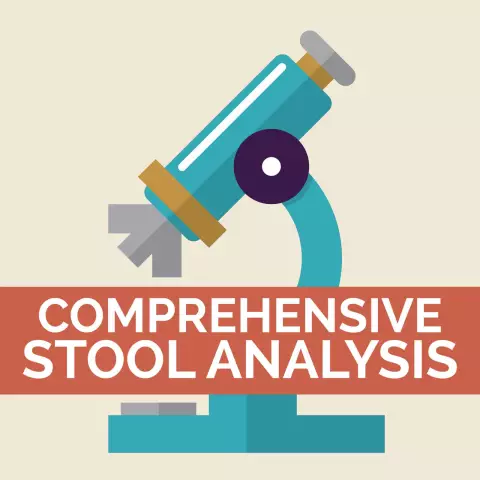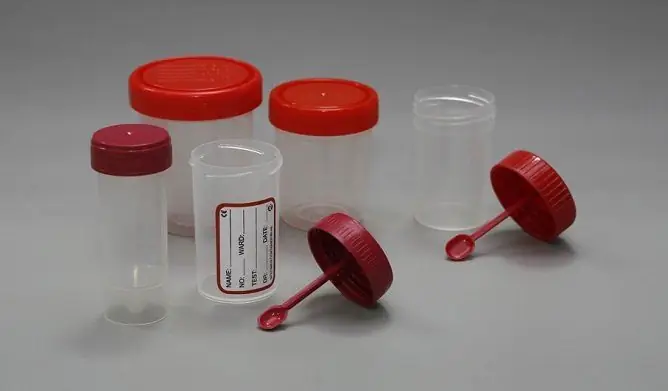- Author Rachel Wainwright [email protected].
- Public 2024-01-15 19:51.
- Last modified 2025-11-02 20:14.
Analysis of feces for a coprogram: what is it, indicators, norms, decoding
The content of the article:
- How to donate feces for coprogram correctly
- Coprogram indicators and norms
-
Decoding the coprogram results
- Feces
- Consistency
- Colour
- Smell
- Acidity
- Muscle fibers
- Fat
- Cellulose
- Starch
- Iodophilic flora
- Epithelium
- Erythrocytes
- Leukocytes
- Helminths and other infectious agents
- Slime
- Crystals
- Bilirubin
Stool analysis for coprogram (coprogram, general analysis of stool, clinical analysis of stool) is a laboratory study of stool, during which it is possible to assess the state of the human digestive system. The coprogram includes the determination of the physical properties of feces (macroscopic examination), its chemical composition and microscopic examination.

Coprogram allows you to assess the state of the organs of the digestive system Coprogram allows you to assess the state of the organs of the digestive system
Feces are a collection of undigested food residues, as well as waste products of the body, which are released into the external environment from the distal intestines during the act of defecation. The specific smell of feces is due to the presence of volatile substances (hydrogen sulfide, indole, skatole, etc.) in them. The color of feces is due to the presence of stercobilin and other bile pigments in them. About 30% of the dry mass of feces is occupied by microorganisms that belong to the normal intestinal microflora.
Coprology, or the scientific study of feces, makes it possible to determine the activity of enzymes and the digestive capacity of the digestive organs, the evacuation function of the intestine, the presence of inflammatory processes in the organs of the gastrointestinal tract, parasites, as well as the state of the intestinal microflora.
The coprogram can be carried out for prophylactic purposes (for example, during pregnancy), as part of a comprehensive diagnosis of diseases of the digestive system, as well as to evaluate the treatment. The analysis is part of a set of studies that are carried out for children with diseases of the gastrointestinal tract.
How to donate feces for coprogram correctly
You should consult your doctor before testing. The specialist will explain how to properly prepare and collect the material, what this analysis shows, how much is valid, how long the result is ready. The conditions for preparation and delivery, as well as the amount of material required for analysis, may differ in different laboratories.
Before the study, it may be necessary to cancel the medications taken (laxatives, iron, bismuth, enzymes, barium sulfate, rectal suppositories, etc.). On this account, you should also consult with the doctor who wrote out the referral for the analysis.
Coprogram is not prescribed in the presence of bleeding hemorrhoids, after colonoscopy and radiological examination, for women during menstruation.
Do not collect material for research after enemas or laxatives.
For analysis, feces are collected after spontaneous bowel movements in a clean, dry container. Everything necessary to collect material for analysis is prepared in advance.
It is recommended to collect feces in specially designed plastic containers with a sealed lid using a spatula spoon, which can be purchased at a pharmacy or laboratory before testing. Usually, 10-15 g of material is enough for a coprogram, you do not need to take a full container for analysis.
It is desirable to deliver the material to the laboratory within two, but no later than eight hours after collection, during which time it is suitable for analysis.
Coprogram indicators and norms
The table shows normal values for the main indicators of the coprogram.
Index Norm Consistency Dense The form Decorated Colour Brown Smell Unsharp, fecal Reaction (pH) 6.0-8.0 Leftover undigested food Absent Muscle fibers striated Absent Unstated muscle fibers Single in the preparation Fat neutral Absent Fatty acid Absent Fatty acid salts Insignificant amount Digestible vegetable fiber Absent Intracellular starch Absent Extracellular starch Absent Iodophilic flora (normal) Single in the preparation Iodophilic flora (pathological) Absent The epithelium is flat Absent The epithelium is cylindrical
Absent Leukocytes Absent Erythrocytes Absent The simplest Absent Helminth eggs Absent Yeast mushrooms Absent Slime Absent Crystals Absent Bilirubin Absent Decoding the coprogram results
Feces
Normally, clinically healthy adults with a mixed diet excrete 100-200 g of feces per day, but the amount may vary depending on the food consumed and the presence of pathologies. So, it changes when the flow of bile into the intestine is disturbed, insufficient digestion in the small intestine, constipation, colitis with diarrhea or ulceration, pathologies of the pancreas, accelerated evacuation from the intestine.
Consistency
The oily consistency of feces may indicate the presence of insufficiency of the exocrine function of the pancreas, a violation of the flow of bile. Liquid feces are noted with putrefactive dyspepsia, accelerated evacuation from the small intestine, colitis. Gruel-like feces are excreted in dyspepsia, colitis with diarrhea and accelerated evacuation from the large intestine. The frothy consistency of feces is characteristic of fermentative dyspepsia; sheep feces are excreted in colitis with constipation. Dense stool in lumps, which is released once every few days, is characteristic of constipation.
Colour
With obstructive jaundice, feces become discolored, with bleeding from the upper digestive tract, tarry feces (melena) are released, with bleeding from the large intestine, the feces are colored red. Light brown stool may indicate an accelerated evacuation from the large intestine. Yellow stools are observed with fermentative dyspepsia and insufficient digestion in the small intestine, light yellow stool may indicate pancreatic insufficiency. Green feces in infants are most often a variant of the norm and appear with the mother's dietary habits, but can also serve as a sign of malnutrition or inflammation of the intestinal mucosa.
Smell
A putrid odor appears in feces with insufficient gastric digestion, intestinal movement disorders, putrefactive dyspepsia. A fetid odor of feces may indicate a violation of the pancreas, insufficient flow of bile into the intestines. A sour smell occurs with fermentative dyspepsia.
Acidity
A weakly alkaline reaction of feces is observed with insufficient digestion in the small intestine, alkaline - with insufficient gastric digestion, pathologies of the pancreas, colitis, constipation. A sharply alkaline fecal reaction indicates putrefactive dyspepsia.
An acidic reaction in feces may indicate an inflammatory process in the small intestine, a harsh acidic reaction to fermentative dysbiosis or colitis.
Muscle fibers
A significant content of insufficiently digested connective tissue and muscle fibers in the feces (creatorrhea) may be due to disorders of the secretory function of the stomach and / or the function of the pancreas.
Fat
Excessive excretion of fat in the feces (steatorrhea) may indicate insufficiency of the functions of the pancreas, impaired bile secretion.
Cellulose
Digestible fiber is found in feces in case of insufficient gastric digestion, digestion in the small intestine, fermentative dyspepsia, ulcerative colitis. Indigestible vegetable fiber has no diagnostic value.
Starch
Undigested starch in the sample (amilorrhea) is a sign of small intestine pathology.
Iodophilic flora
Iodophilic flora is detected in fermentative dyspepsia, insufficient digestion in the small intestine, disorders of the pancreas, accelerated evacuation from the large intestine.
Epithelium
A significant number of epithelial cells in feces is characteristic of inflammatory processes, intestinal neoplasms, and dysbiosis.
Erythrocytes
Erythrocytes are detected in feces with ulcerative colitis, hemorrhoids, rectal fissures, polyps, dysentery, malignant neoplasms.
Leukocytes
A significant number of leukocytes in the stool, as a rule, indicates an inflammatory process in the intestine (ulcerative colitis, dysentery, etc.), it can also be a sign of a neoplasm.
Helminths and other infectious agents
The detection of helminths and / or their eggs, protozoa, yeast-like fungi indicates infection with one or another parasite or microorganism.
Slime
It is found in colitis with constipation, ulcerative colitis, constipation.
Crystals
Calcium oxalate crystals in feces can be a sign of amoebic dysentery, gastric insufficiency, allergic processes, helminthic invasions.
Hemosiderin is detected in feces after intestinal bleeding.
Bilirubin
Bilirubin can be found in feces with increased intestinal peristalsis, accelerated evacuation of intestinal contents, dysbiosis.
YouTube video related to the article:

Anna Aksenova Anna Aksenova Medical journalist About the author
Education: 2004-2007 "First Kiev Medical College" specialty "Laboratory Diagnostics".
Found a mistake in the text? Select it and press Ctrl + Enter.






